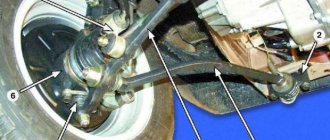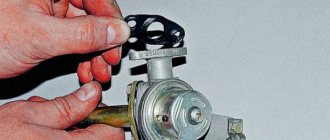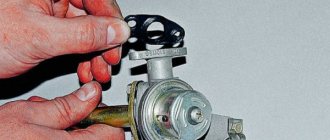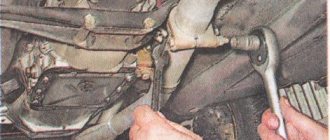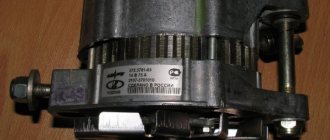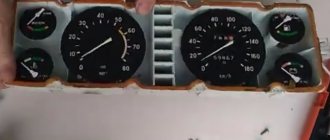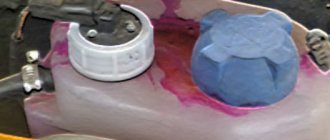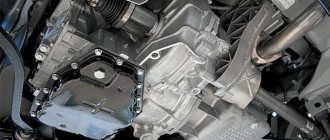FRONT SHOCK ABSORBER VAZ 2107
The suspension design of any car uses shock absorbers to increase the comfort and safety of movement. Since VAZ 2107 shock absorbers, like other suspension elements, are subject to constant loads and fail over time, you need to know how faults manifest themselves and be able to replace the part if necessary.
PURPOSE
The normal and correct operation of the front suspension of the “seven”, and the rear one too, is ensured by the main structural elements - a spring and a shock absorber. The spring softens the shocks of the body while the car is moving. When hitting any kind of obstacle (potholes, bumps), the wheel comes off the road, and thanks to the elastic element it returns to work. When the wheel hits the surface, the body presses down with its entire mass, and the spring should make this contact as soft as possible. The work of the shock absorber is aimed at dampening vibrations of the elastic element as quickly as possible when the body rocks. The part is completely sealed and, when fully operational, is capable of absorbing about 80% of impact energy. The shock absorbers of the front suspension of the VAZ 2107 are attached with the lower eye through the bracket to the lower suspension arm. The damper rod is fixed through the support glass using a nut.
Important elements of the front suspension are springs and shock absorbers
TABLE: PARAMETERS OF STANDARD FRONT SHOCK ABSORBERS FOR VAZ 2107
| vendor code | Rod diameter, mm | Case diameter, mm | Body height (excluding stem), mm | Rod stroke, mm |
| 21012905004, 21012905402 | 12 | 41 | 215 | 112 |
DEVICE
The front end of the VAZ 2107 comes from the factory with oil-filled twin-pipe shock absorbers. Structurally, in addition to the flask, piston and rod, they have another cylinder with a flask containing liquid and a piston element. During operation, the liquid is compressed by the piston, which causes it to flow through the valve into the outer cylinder. As a result, the air is further compressed. During rebound, due to the opening of the valves on the piston, the liquid flows back into the inner cylinder. This design of shock absorbers, although simple, has certain disadvantages. Since liquid from one flask to another passes through valves under high air pressure, aeration occurs, during which the liquid mixes with air, causing its properties to deteriorate. In addition, due to two flasks, the damper is cooled worse, which reduces its efficiency.
Design of shock absorbers of the front and rear suspensions: 1 - lower eye; 2 — compression valve body; 3 — compression valve discs; 4 — throttle disk of the compression valve; 5 — compression valve spring; 6 — compression valve cage; 7 — compression valve plate; 8 — recoil valve nut; 9 — recoil valve spring; 10 — shock absorber piston; 11 — recoil valve plate; 12 — recoil valve discs; 13 — piston ring; 14 — recoil valve nut washer; 15 — throttle disk of the recoil valve; 16 — bypass valve plate; 17 — bypass valve spring; 18 — restrictive plate; 19 - reservoir; 20 - rod; 21 - cylinder; 22 — casing; 23 — rod guide bushing; 24 — sealing ring of the tank; 25 — rod seal race; 26 — rod seal; 27 — gasket of the rod protective ring; 28 — rod protective ring; 29 — tank nut; 30 — upper shock absorber eye; 31 — nut securing the upper end of the front suspension shock absorber; 32 — spring washer; 33 — shock absorber mounting pad washer; 34 — pillows; 35 — spacer sleeve; 36 — front suspension shock absorber casing; 37 — rod buffer; 38 - rubber-metal hinge
How to replace front shock absorbers on a VAZ 2101-VAZ 2107?
Both shock absorbers are replaced in the same way, so we will show their replacement only using the example of one shock absorber!
1) First, drive the car into the inspection hole, or hang it up using a lift.
2) Now open the hood and pick up the special key (If you don’t have it, then use small pliers). Next, place a special wrench on the shock absorber rod, which is indicated by the number “1” in the photo, thereby reducing the likelihood of the rod turning along the axis.
Replacing the front shock absorber sales unit of VAZ 2101-07.
I created this video with the help of YouTube Video Editor ()
Replacing the lower silent block of the front shock absorber VAZ 2101-2107
Very briefly about the replacement
lower silent block
of
the front shock absorber VAZ
2101-2107 Very briefly about replacing the lower.
Immediately after this, use a wrench labeled “2” to unscrew and then remove the nut, after the nut, remove the spring washer, as well as the cushion washer and the upper shock absorber mounting cushion itself.
Read also: Road sign main road
If you are working on a lift, then perform this operation with the car standing on the ground!
3) Then crawl under the car, and there, unscrew the two nuts that secure the bracket to the lever.
Unscrew the nuts carefully, because above them there are spring washers that will also need to be carefully removed. If both lower nuts are soured, then apply WD-40 grease to them, thereby ensuring they can be easily loosened!
4) When both nuts that secure the bracket to the lever are unscrewed, pull down the shock absorber and therefore remove it from the car.
5) When the shock absorber is removed, remove the lower cushion from its rod.
6) Next, holding the bolt from turning with one wrench, with the other, unscrew the nut that secures the bracket to the shock absorber and then remove the bolt, thereby removing the small washer and the bracket itself.
You can install the removed bracket on a new shock absorber if it is missing!
Installing a new car front shock absorber is carried out in the reverse order of removal.
Before installing a new shock absorber, pull out the rod all the way. After which, for convenience, you can first put a washer on the rod, then a cushion, and then screw the nut on top!
If you do all the work on a lift, then lower the car to such a state that it touches the ground, in other words, so that its suspension is loaded under the weight of the car itself!
If the shock absorber rod comes out from above but not all the way, then first put the cushion washer on it and then screw the nut on top. When the nut is screwed on, using a lever principle, use a screwdriver or wrench to pull the rod up to the top until it stops!
To make it easier for you to understand the procedure for replacing shock absorbers, then watch a video below, prepared especially for you, in which everything is described and explained in detail.
SHOCK ABSORBER FAULTS
Any car malfunction always manifests itself in the form of extraneous noise, unusual behavior of the vehicle or other signs. Problems with shock absorbers also have certain symptoms, and if they are detected, you should not delay replacing the dampers.
OIL LEAKING
The most common sign that a shock absorber has become unusable is a fluid leak. Leaks on the body indicate a loss of seal in the oil reservoir. As a result, not only leaks occur, but also air leaks. In this case, the damper rod has free movement, i.e. it moves without any effort, and the part loses its functionality. If signs of smudges have just appeared on the shock absorber, it will serve a little longer, but you should not leave it without attention and it is better to replace it in the near future.
The main malfunction of shock absorbers is leakage of working fluid
BODY ROLLING
Since springs and shock absorbers work together to dampen vibrations that occur when driving over bumps, contact with the road may be lost if the damper fails. In this case, shaking increases, the body sways, and the level of comfort decreases. The car becomes rolly, and when it hits obstacles it sways for some time. The easiest way to check the shock absorbers of your “seven” is to press the wing, try to rock the body, and then release it. If the car continues to swing on the springs for some time, then this is a clear sign of a faulty damper.
To check the shock absorbers, you need to swing the body by the fender or bumper
BODY ROLL
One symptom that indicates problems with the suspension shock absorbers is body roll when cornering. This behavior of the car negatively affects safety, since the quality of braking, as well as vehicle control, suffers. If liquid has leaked from the damper, it will be quite difficult to keep the car turning, which is especially dangerous in winter. When the mileage of the products in question is more than 60 thousand km, which also depends on the quality of the parts themselves and the operating conditions of the vehicle, handling may noticeably deteriorate. But since the process does not occur at one moment, but gradually, the driver practically does not notice this and rolls can be perceived as a normal phenomenon.
NOISE IN THE SUSPENSION
Extraneous sounds in the suspension, uncharacteristic of its operation, indicate the need to check and service this mechanism. When dampers and their bushings wear out, the ability to effectively support the weight of the machine is lost. In addition, so-called shock absorber breakdowns often occur.
Suspension breakdowns are metal elements touching each other, which leads to a knocking sound.
UNEVEN OR INCREASED TIRE WEAR
If it has been noticed that the tire tread has uneven wear or wears off too quickly, then this is a clear sign of problems with the suspension. With faulty shock absorbers, the wheel moves vertically with a much greater amplitude, which leads to uneven tire wear. When driving, extraneous noise appears on such wheels.
If your tires wear unevenly, one of the likely causes is problems with the shock absorbers.
DIVE WHEN BRAKING
Among car owners there is such a thing as “the car bites.” If the dampers fail, the front of the car will dive during braking, and the rear will sag when accelerating. This is explained by the fact that parts that have become unusable do not cope with their function, that is, they do not support the weight of the machine.
BREAKING ATTACHMENT
One of the infrequent breakdowns of the front shock absorbers is the breakage of the lower eye. The reasons for this phenomenon may be different:
- installation of low-quality parts;
- making changes to the standard suspension design.
Sometimes it happens that the fastening of the rod along with the glass breaks off. This phenomenon is accompanied by a knocking sound while driving. It is quite easy to identify a breakdown by opening the hood and looking at the place where the upper part of the shock absorber is attached.
When the upper shock absorber mounting cup breaks, a knocking sound appears in the suspension
The problem is resolved by welding. Some Zhiguli owners reinforce this part of the body with additional metal elements.
CHECKING SHOCK ABSORBERS ON THE STAND
The most accurate method for diagnosing shock absorbers is to test the car suspension on a vibration stand. Using such equipment, the properties of each damper are checked separately. At the end of the diagnostics, the device will display a diagram based on the results of measurements of axial vibrations. By comparing the diagram with the permissible vibration value of a working damper, you can understand the condition of the parts.
VIDEO: DIAGNOSTICS OF CAR DAMPERS AT THE STAND
SEQUENCE OF ACTION:
- we lift the VAZ 2107 car with a jack from the replacement side (we hang the rear wheel), not forgetting to tighten the hand brake;
- spray WD-40 on the mounting threads and go drink tea. After 15 minutes, the Teflon lubricant penetrates inside, which makes unscrewing easier.
- We begin to unscrew the bottom bolt, holding it on one side and using a ratchet on the other, and then knock the bolt out with a hammer through the plastic plate so as not to damage the thread.
- The bottom edge now dangles freely
- Now we calmly unscrew the upper fastening bolt with a wrench, and, using a pry bar, pry the cylinder to the side and remove it.
Now we move the jack to the second half and repeat the same steps.
You can use whatever you want - oil or gas, but be sure to use the same ones in a pair. This is how the rear shock absorbers are replaced. Front shock absorbers are replaced if the same symptoms occur: knocking and “breakdowns” when the front wheel gets into a hole, or the front suspension gets oily.
The tool you need are keys 6, 13, 17.
Recommendations
Comments 18
crappy oil... the shock is checked by machine, not by hand. although according to the symptoms the left one is a corpse. And then, are the shock absorbers oil or gas oil? plus, as a rule, performance is not the main criterion, the main criterion is the presence of oil in the shock absorber... there is no point in lubricating the silent parts with oil, they should not rotate at all when in place. like the metal bushing in the rubber band... looking at the rubber in general, a question arises. how did you travel? With such silents, the bridge dangles like shit from an ice hole, the car jerks from side to side when pedaling the accelerator.
How many people, so many opinions. In my opinion, the oil is good. It's not clear by car. According to the main methods of verification, it is alive, but rather harsh. Ammorts Niva oil. The car behaved stably, did not dangle anywhere, only rumbled sometimes. After the second trip I went to check and saw that my ears were hanging on the lower rubber bands. Well, I changed it right away.
We opened up a couple of engines using Lukoil oil... the bed, the head... everything was covered in an even 3-4 mm layer of soot. dirt just settles in the engine... because... many people say that nivo-shocks themselves are harsher than classic ones, although I don’t know... I haven’t used them... in any case, if they work differently, I would recommend changing them... maybe the speeds were low, since I didn’t notice...
crappy oil... the shock is checked by machine, not by hand. although according to the symptoms the left one is a corpse. And then, are the shock absorbers oil or gas oil? plus, as a rule, performance is not the main criterion, the main criterion is the presence of oil in the shock absorber... there is no point in lubricating the silent parts with oil, they should not rotate at all when in place. like the metal bushing in the rubber band... looking at the rubber in general, a question arises. how did you travel? With such silents, the bridge dangles like shit from an ice hole, the car jerks from side to side when pedaling the accelerator.
By the way, Lil Mobil Ultra, which you pour. It turned out to be complete slag. After 3 thousand I drained the black slurry and had to flush the engine. So, it depends. In Luka, I’m at least sure that this is factory oil, and not a broken badya in the basement of the Khachami.
Read also: Hyundai Tussan ground clearance
Replacing front shock absorbers on a VAZ 2101-VAZ 2107
Car shock absorbers alone determine how the car will behave in the future on smooth and uneven roads. Over time, car shock absorbers deteriorate and therefore need to be replaced. In this article, we have written detailed instructions on how you can replace the front shock absorbers on cars of the “Classic” family.
To perform the replacement, you will need the following tools: First, be sure to stock up on a set of basic wrenches and new shock absorbers. And also, if you have one, take with you a special key for removing shock absorbers; for clarity, it is shown in the figure below:
Which shock absorbers do you prefer: “Gas-oil” shock absorbers or conventional “Hydraulic” ones? (Write your answer in the comments)
When do you need to change front shock absorbers?
They must be replaced if:
- Loss of its properties, that is, loss of efficiency in damping vibrations.
- And it must also be replaced with a new one if it starts to leak and as a result becomes oily.
To properly verify whether the shock absorbers are working or not, you can read the article entitled: “Checking shock absorbers for performance”!
SEQUENCE OF ACTIONS IN THE FRONT:
We hang the wheel in front in the same way, then open the hood. There is access to the rod of the front shock absorbers of the VAZ 2107.
- Unscrew the nut using a 17 wrench and holding it with a 6 wrench.
- Then, from below, under the car, we turn out the bracket using a 13-mm open-end wrench and turn it out, and then remove it together with the shock absorber:
- Now we repeat all the steps on the other side, remove the second shock absorber, and then in the reverse order, just install new ones. For some car owners, on the contrary, it is easier to change one side first, so as not to jack the VAZ 2107 four times.
Replacement should ideally be carried out immediately at the front and rear to ensure maximum smoothness, but some “stingy” enthusiasts argue that such a replacement is more expensive.
Sources
- vaz.ru/remont/zamena-amortizatorov.html
- bumper.guru/klassicheskie-modeli-vaz/hodovaya-chast/peredniy-amortizator-vaz-2107.html
- zen.yandex.ru/media/uremont/zamena-perednih-amortizatorov-vaz2107–kak-zamenit-svoimi-rukami-5dfce19598fe7900ad9390b2?utm_source=serp
- drive2.ru/l/4951825/
- zen.yandex.ru/media/vaganov/zamena-perednih-amortizatorov-vaz2107-svoimi-rukami-5caa553a78ee6d00af774091

